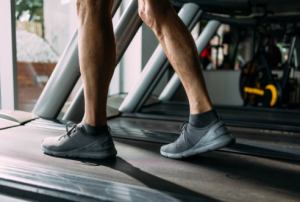You may have heard that cardio kills your muscle gains — but think again! Cardio is actually an important part of an effective strength training program. Not only can it help improve your gym performance, but it also helps prevent chronic illnesses like heart disease, lung conditions, high blood pressure, obesity, and diabetes.
Let’s talk about how cardio — especially treadmill workouts — can help you get the most out of your fitness routine.
What Makes Treadmill Workouts Effective?
While most gyms offer a variety of cardio machines, the treadmill is one of the most versatile. You can use it for speed training, HIIT, heart rate zone training, warm-ups, and cool-downs.
Treadmill workouts are great for challenging your cardiovascular system and improving your VO₂ max, which is the gold standard for measuring cardiorespiratory fitness. If your goals include building strength, improving overall fitness, or staying healthy, increasing your VO₂ max means you’re on the right path. The higher your VO₂ max, the more efficiently your body uses oxygen during exercise — meaning longer and more effective workouts.

How Cardio Supports Muscle Growth
Muscles need oxygen to work, and it’s your cardiovascular system that delivers oxygen — along with the nutrients needed for muscle repair and growth — throughout your body. If you’re only focused on lifting weights and skipping cardio, you could be missing out on gains.
Also, if your goal is body recomposition — losing fat while gaining muscle — adding cardio can help you reach those goals faster by supporting fat loss while improving endurance and recovery.
Can Treadmill Workouts Help You Build Muscle?
Absolutely. Treadmills aren’t just for weight loss — they can also help you build muscle in a way that complements traditional strength training.
The type of treadmill workout you do influences the muscle fibers you activate. Longer, lower-intensity runs target Type I (slow-twitch) muscle fibers, while sprints target Type II (fast-twitch) fibers.
Fast-Twitch vs. Slow-Twitch Muscle Fibers
Your muscles contain both Type I and Type II fibers. Larger muscle groups like your glutes and quads tend to have more Type II fibers, while your core muscles often have more Type I fibers.
-
Type I fibers help with stability and endurance — they’re slow to fatigue.
-
Type II fibers produce power and speed but tire quickly.
That’s why you can sit upright for hours using your core muscles without feeling worn out, but sprinting at top speed can only last a few seconds.
For example, elite sprinters usually have a higher percentage of Type II fibers in their legs, while endurance runners have more Type I. Training both types of muscle fibers allows you to unlock your full muscle-building potential.
How to Add Treadmill Workouts to Your Strength Routine
Ideally, try to schedule cardio and strength training on separate days. If that’s not possible, do your treadmill workouts after weightlifting — not before.
Why? Doing intense cardio before lifting can tire out your muscles and reduce your strength performance, increasing the risk of injury. Stick to light treadmill warm-ups before lifting sessions.

After lifting, doing a short, high-intensity sprint workout can help activate your fast-twitch fibers and boost blood flow to deliver oxygen and nutrients to your muscles. This speeds up recovery thanks to a process called EPOC (Excess Post-Exercise Oxygen Consumption).
EPOC is the recovery phase following intense exercise, where your body works hard to restore energy levels and flush out waste products like lactic acid. It also increases the release of important muscle-building hormones like growth hormone (GH).
Best Treadmill Workouts for Muscle Building
To support strength development, effective treadmill workouts combine speed, incline, and duration to challenge your muscles. While treadmill training isn’t resistance training per se, changing the settings can help target and stimulate muscle growth.
The best combo of incline, speed, and time varies depending on your fitness level and goals. Play around with the settings until you find a routine that’s challenging but sustainable. If it feels too easy, add a few more minutes or increase the incline by 1% at a time until it feels tough — but doable.
Tips to Make Treadmill Workouts Work for You
If your goal is muscle growth, aiming to trigger EPOC after your treadmill session is key. Not into sprinting? No problem — interval training can deliver the same benefits. Try alternating high-intensity bursts with periods of recovery. If your interval training session lasts more than 5–10 minutes, consider doing it on a different day than your lifting to keep your energy levels high.
Final Thoughts
The treadmill is one of the most versatile pieces of gym equipment out there. Whether you’re warming up, doing endurance work, or sprinting to boost power, treadmill workouts can complement your strength training and challenge your body in new ways.
Whether your focus is building strong legs or improving your overall health, the right treadmill routine can push your limits without wearing you down. Listen to your body and be patient as you figure out what works best for your goals.

